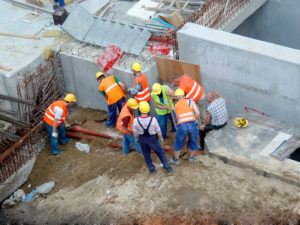
When a project falls behind schedule, there are many different tactics contractors and subs can use to get back on track. One common approach is to trade stack a job site. Trade stacking can be an effective method, but if done improperly can lead to several potential costs and risks.
What is trade stacking?
Trade stacking, also known as overcrowding, is simply scheduling more trades to a single area or portion of the job site. The idea is, the more people, the more work can be done. In theory, this seems right; and in many cases, it may be. The problem is, when the schedule is stressed, there is a gut reaction response to make it work. Panic mode ensues, and many project teams find themselves scrambling to the finish line. And why not? The ability to roll with the punches and keep clients happy is just plain good business. But without proper coordination and oversight, trade stacking can cause more problems than it solves.
The root causes of trade stacking
One of the main ways trade stacking arises is due to poor management and scheduling. The ability to properly sequence work on a job site is indispensable to the project’s success. If subs are not properly scheduled, they may not be able to begin performance, let alone perform efficiently. This can cause a ripple effect of potential risks and issues.
Another way trade stacking can come up is through schedule acceleration. Acceleration can be in response to an unforeseen delay, or when a client simply requests an earlier delivery date. In order to meet the desired completion date, many GCs or project managers will decide to “fast-track” their schedules. This requires stacking trades either in parallel or in partial parallel of each other.
Improper trade stacking risks
Scheduling errors caused by poor project management can easily lead to cost overruns and disputes. Disputes are the product of days, dollars and disasters, which can all cause the project to take a massive financial hit.
Disruption claims
One potential claim is disruption due to loss of productivity. When a sub is bidding or estimating a project, they base their pricing under the assumption that there will be minimal interference with their work. When a trade can’t work as efficiently as they typically can, they are forced to add more workforce or approve more overtime. These cost overruns are then passed along to the project.
Delay claims
When disruption becomes severe, it can cause project delays. Delays, especially those that impact the critical path, not only increase that specific sub’s costs but everyone else’s as well. Think of a painter showing up to a build, and realizing there are still electricians and plumbers doing rough-ins. Their inability to work can result in rescheduling which can push the completion date further and further back.
Defective work
Having too many trades concentrated in one work area can cause stress and distractions. To avoid this many workers will try to speed up performance and potentially overlook crucial aspects of their work; leading to defects. Even if this isn’t the case, stacking all that work together can cause work that was otherwise adequate, to be damaged. Disputes over work quality can sour business relationships, take up valuable time and result in costly reworks.
Trade stacking the right way
The keys to properly using trade stacking is coordination and communication. Proper sequencing can help avoid subs stepping on each other’s toes. Ideally, if there are multiple trades on the project at once, they will be working in shifting locations. For example, having all the “finish-trades” follow up the group of rough-in trades. Moving in phases to avoid any conflict or delays. As long as the trade stacking and work-flows are logically coordinated, the effort may work. Without it, the project could end up costing much more than anticipated.
Additional Resources
- Construction Schedule | Tools for Completing Your Project On Time
- The Critical Path Method Creates More Efficient Construction Schedules
- Time Impact Analysis | Identifying the Impact of Extra Work


